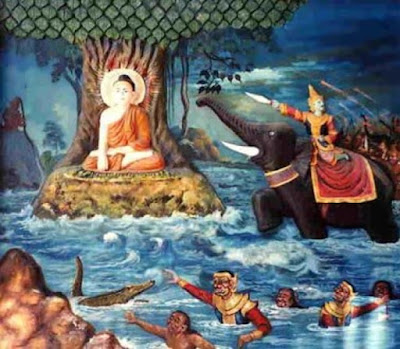
.
SUTRA: Mara must be crazy
 |
| He's very harmful, but Cupid's so cute! |
- [2: Namuci is another name for Mara that means "One who does not let go" (his hold over beings easily).]
 |
| Why should I exert (padhana) myself? |
"'But what is to be obtained by striving? It is difficult to enter the path of exertion [effort, padhana]. It is difficult to do and difficult to maintain.'"
 |
| Mara in Ancient Rome is Cupid. |
"Friend of the negligent, O Evil One, for what reason have you come here? Those who still have need for merit, Mara may consider it worthwhile addressing them. I have confidence (saddha) and energy (padhana) and wisdom.
"Being thus bent on striving [toward the supreme goal of full enlightenment and complete liberation], why do you ask me to live [on wandering in samsara]?
 |
| Five topless women in a tub with Mara at the window behind them (express.co.uk) |
 |
| Mara's seductive daughters try to entice |
"On the wasting away of the flesh [the basis of sensuality], the mind becomes more and more serene. And mindfulness, wisdom, and concentration (samadhi) are firmly established. In me, who abides enduring such an extreme experience, the mind does not long for sensual pleasures. See the purification of a living being!
- [Analyzing the body into the Four Elements (dhatus) temporarily frees one from sensual craving for it. There are specific sets of practices on how to practice this analysis set out in The Path of Purification, a famous commentarial work by Buddhaghosa.]
 |
| The wandering ascetic Siddhartha kept meditating as Mara attacked in waves. |

"Sensual Desire is your first army, the second is Discontent, the third Hunger-Thirst, the fourth Craving, the fifth Sluggishness-Laziness, the sixth Fear, the seventh Indecision, and the eighth Disparagement of Others and Stubbornness: gain, fame, honor, prestige wrongly acquired and whoever praises oneself and despises others -- these, Namuci, are your armies, the strike forces of the Dark One [3].
- [3: Kanha, the "Dark One" (Sanskrit Krishna), is another name for Mara. He is Ancient Indian lore's Cupid (Kamadeva) and personifies sensual passions. He carries a lute (vina), mentioned at the close, which he plays to captivate beings. His other equipment includes a bow, arrows, a noose, and a hook.
"I wear muñja-grass! [4] Shame on life here in this world! It is better for me to die in battle than to live defeated. Some recluses and brahmanas are not seen (exerting themselves) here, so immersed are they (in worldliness). They are not aware of that path by which those of perfect conduct walk.
- [4: Indian warriors used to wear a tuft of this grass, called muñja, on their head or headgear to indicate that they were prepared even to die in battle and determined not to retreat whatever might happen.]
 |
| Cupid (at left) in Indian lore is Kamadeva. |
"Having mastered the mind and firmly established mindfulness (sati), I shall wander from country to country guiding many disciples [to freedom]. And they will be diligent and energetic in practicing this teaching, the teaching of one free of sensual craving, and they will go where, having gone, one no longer grieves."
 |
| Mara in Ancient Greece is Eros. |
"Not finding anything edible the crow left that place. As with the crow and the stone, we leave Gotama [Siddhartha Gautama, the Buddha], having approached and become disheartened."
Overcome by sorrow his lute fell from his arm and thereupon the unhappy spirit disappeared from that place.
Wait, is Mara real?
 |
| Interested in my daughters, Sid? |
Mara appears in the texts both as a real person (a deity called Mara Devaputra) and as personification of harm and passions, of the totality of worldly existence, and of death.
Later exclusively Buddhist Pāli language literature often speaks of a "Fivefold Māra" (pañca-māra):
- the deity Mara (devaputta-māra)
- the defilements as Mara (kilesa-mara)
- the aggregates as Mara (khandha-mara)
- the karma-formations as Mara (karma-mara)
- Māra as death (maccu-mara).
 |
| These daughters do not interest me. |
According to tradition, when the Bodhisatta (Buddha-to-be) was seated under the bodhi-tree, Māra tried in vain to obstruct his attainment of enlightenment, first by frightening him with demons and so on then with his Three Daughters' allurements.
This episode is called "Māra's War" (māra-yuddha). For seven years Mara followed the Buddha, looking for any weakness in him, that is, six years before the enlightenment and one year after it (Sn. v. 446).
He also tried to induce the Buddha to pass away into final nirvana without teaching the Dharma and also when the time for the Buddha's final nirvana actually came, he urged him on. But the Buddha acted on his own insight in both cases. See DN 16. For (3) Mara as the aggregates, see S. XXIII, 1, 11, 12, 23.
(Strange Things) Anunnaki in Antarctica: realizing alien invasion on Earth


































































































































































































































No comments:
Post a Comment